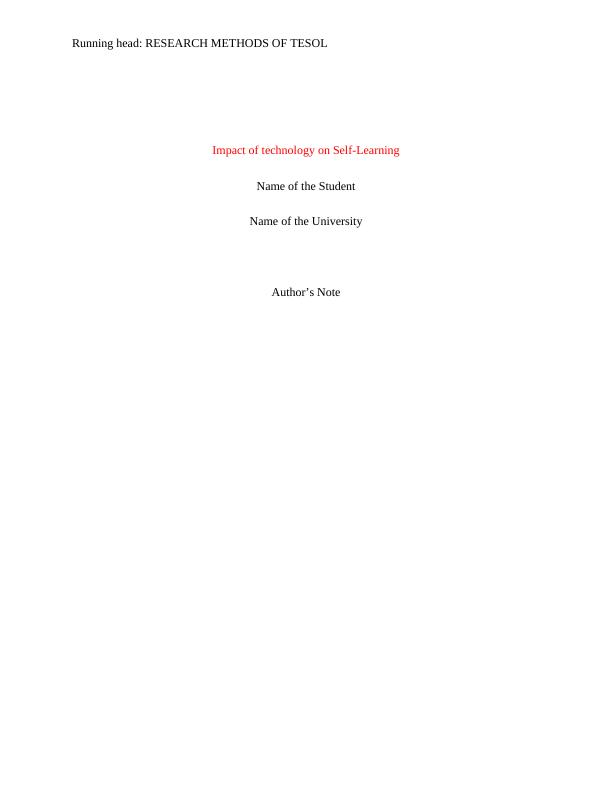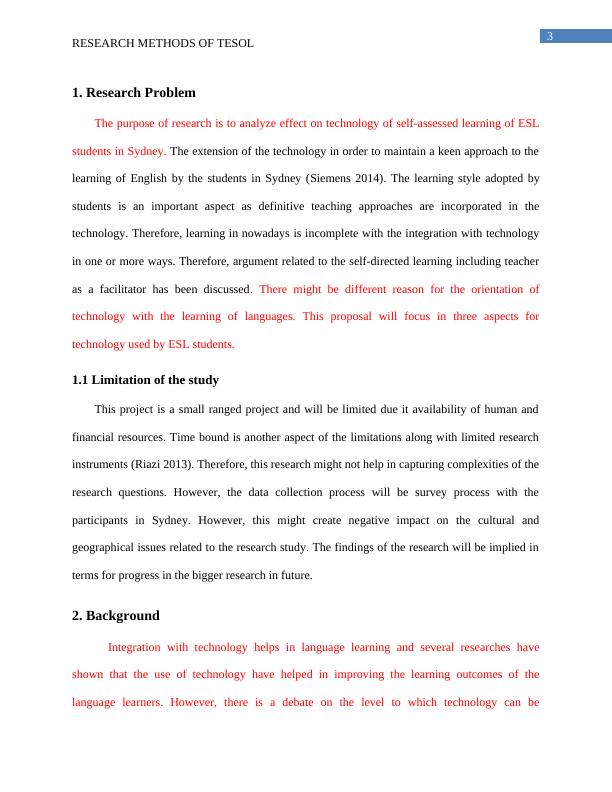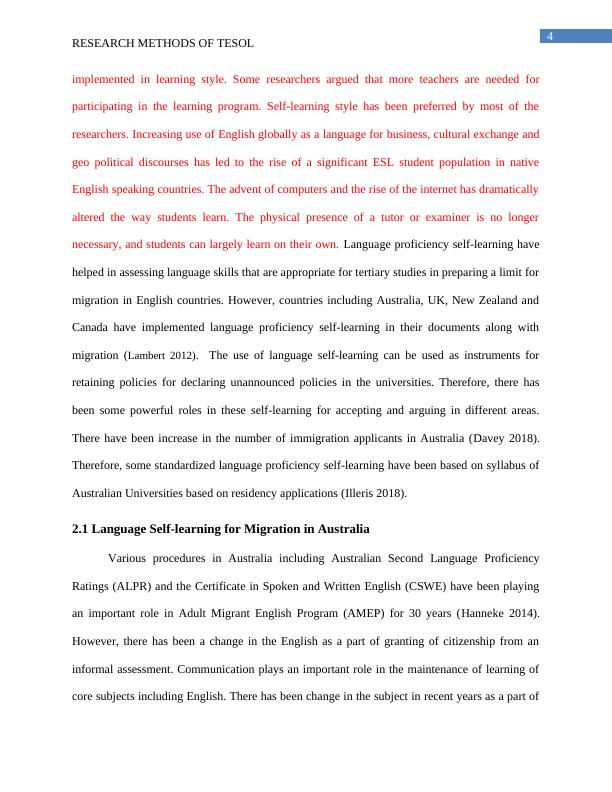Impact of Technology on Self-Learning for ESL Students in Sydney
Added on 2023-06-08
11 Pages2533 Words321 Views
Running head: RESEARCH METHODS OF TESOL
Impact of technology on Self-Learning
Name of the Student
Name of the University
Author’s Note
Impact of technology on Self-Learning
Name of the Student
Name of the University
Author’s Note

2
RESEARCH METHODS OF TESOL
Table of Contents
1. Research Problem........................................................................................................................3
1.1 Limitation of the study...........................................................................................................3
2. Background..................................................................................................................................4
2.1 Language Self-learning for Migration in Australia...............................................................4
3. Literature Review........................................................................................................................5
4. Ethical Considerations.................................................................................................................7
References........................................................................................................................................8
RESEARCH METHODS OF TESOL
Table of Contents
1. Research Problem........................................................................................................................3
1.1 Limitation of the study...........................................................................................................3
2. Background..................................................................................................................................4
2.1 Language Self-learning for Migration in Australia...............................................................4
3. Literature Review........................................................................................................................5
4. Ethical Considerations.................................................................................................................7
References........................................................................................................................................8

3
RESEARCH METHODS OF TESOL
1. Research Problem
The purpose of research is to analyze effect on technology of self-assessed learning of ESL
students in Sydney. The extension of the technology in order to maintain a keen approach to the
learning of English by the students in Sydney (Siemens 2014). The learning style adopted by
students is an important aspect as definitive teaching approaches are incorporated in the
technology. Therefore, learning in nowadays is incomplete with the integration with technology
in one or more ways. Therefore, argument related to the self-directed learning including teacher
as a facilitator has been discussed. There might be different reason for the orientation of
technology with the learning of languages. This proposal will focus in three aspects for
technology used by ESL students.
1.1 Limitation of the study
This project is a small ranged project and will be limited due it availability of human and
financial resources. Time bound is another aspect of the limitations along with limited research
instruments (Riazi 2013). Therefore, this research might not help in capturing complexities of the
research questions. However, the data collection process will be survey process with the
participants in Sydney. However, this might create negative impact on the cultural and
geographical issues related to the research study. The findings of the research will be implied in
terms for progress in the bigger research in future.
2. Background
Integration with technology helps in language learning and several researches have
shown that the use of technology have helped in improving the learning outcomes of the
language learners. However, there is a debate on the level to which technology can be
RESEARCH METHODS OF TESOL
1. Research Problem
The purpose of research is to analyze effect on technology of self-assessed learning of ESL
students in Sydney. The extension of the technology in order to maintain a keen approach to the
learning of English by the students in Sydney (Siemens 2014). The learning style adopted by
students is an important aspect as definitive teaching approaches are incorporated in the
technology. Therefore, learning in nowadays is incomplete with the integration with technology
in one or more ways. Therefore, argument related to the self-directed learning including teacher
as a facilitator has been discussed. There might be different reason for the orientation of
technology with the learning of languages. This proposal will focus in three aspects for
technology used by ESL students.
1.1 Limitation of the study
This project is a small ranged project and will be limited due it availability of human and
financial resources. Time bound is another aspect of the limitations along with limited research
instruments (Riazi 2013). Therefore, this research might not help in capturing complexities of the
research questions. However, the data collection process will be survey process with the
participants in Sydney. However, this might create negative impact on the cultural and
geographical issues related to the research study. The findings of the research will be implied in
terms for progress in the bigger research in future.
2. Background
Integration with technology helps in language learning and several researches have
shown that the use of technology have helped in improving the learning outcomes of the
language learners. However, there is a debate on the level to which technology can be

4
RESEARCH METHODS OF TESOL
implemented in learning style. Some researchers argued that more teachers are needed for
participating in the learning program. Self-learning style has been preferred by most of the
researchers. Increasing use of English globally as a language for business, cultural exchange and
geo political discourses has led to the rise of a significant ESL student population in native
English speaking countries. The advent of computers and the rise of the internet has dramatically
altered the way students learn. The physical presence of a tutor or examiner is no longer
necessary, and students can largely learn on their own. Language proficiency self-learning have
helped in assessing language skills that are appropriate for tertiary studies in preparing a limit for
migration in English countries. However, countries including Australia, UK, New Zealand and
Canada have implemented language proficiency self-learning in their documents along with
migration (Lambert 2012). The use of language self-learning can be used as instruments for
retaining policies for declaring unannounced policies in the universities. Therefore, there has
been some powerful roles in these self-learning for accepting and arguing in different areas.
There have been increase in the number of immigration applicants in Australia (Davey 2018).
Therefore, some standardized language proficiency self-learning have been based on syllabus of
Australian Universities based on residency applications (Illeris 2018).
2.1 Language Self-learning for Migration in Australia
Various procedures in Australia including Australian Second Language Proficiency
Ratings (ALPR) and the Certificate in Spoken and Written English (CSWE) have been playing
an important role in Adult Migrant English Program (AMEP) for 30 years (Hanneke 2014).
However, there has been a change in the English as a part of granting of citizenship from an
informal assessment. Communication plays an important role in the maintenance of learning of
core subjects including English. There has been change in the subject in recent years as a part of
RESEARCH METHODS OF TESOL
implemented in learning style. Some researchers argued that more teachers are needed for
participating in the learning program. Self-learning style has been preferred by most of the
researchers. Increasing use of English globally as a language for business, cultural exchange and
geo political discourses has led to the rise of a significant ESL student population in native
English speaking countries. The advent of computers and the rise of the internet has dramatically
altered the way students learn. The physical presence of a tutor or examiner is no longer
necessary, and students can largely learn on their own. Language proficiency self-learning have
helped in assessing language skills that are appropriate for tertiary studies in preparing a limit for
migration in English countries. However, countries including Australia, UK, New Zealand and
Canada have implemented language proficiency self-learning in their documents along with
migration (Lambert 2012). The use of language self-learning can be used as instruments for
retaining policies for declaring unannounced policies in the universities. Therefore, there has
been some powerful roles in these self-learning for accepting and arguing in different areas.
There have been increase in the number of immigration applicants in Australia (Davey 2018).
Therefore, some standardized language proficiency self-learning have been based on syllabus of
Australian Universities based on residency applications (Illeris 2018).
2.1 Language Self-learning for Migration in Australia
Various procedures in Australia including Australian Second Language Proficiency
Ratings (ALPR) and the Certificate in Spoken and Written English (CSWE) have been playing
an important role in Adult Migrant English Program (AMEP) for 30 years (Hanneke 2014).
However, there has been a change in the English as a part of granting of citizenship from an
informal assessment. Communication plays an important role in the maintenance of learning of
core subjects including English. There has been change in the subject in recent years as a part of

End of preview
Want to access all the pages? Upload your documents or become a member.
Related Documents
Analytical Thinking and Decision Making: A Case Studylg...
|14
|3995
|70
Challenges with ESOL in China: Reasons for Lack of Progress and Recommendationslg...
|42
|15208
|220
Annotated Bibliography on Teaching English to Young Learners and Intercultural Approach to Language Teachinglg...
|5
|1185
|395
Negative Effects of Corrective Feedback in Second Language Writinglg...
|14
|3822
|68
The Mandarins An Overview of the Literacy.lg...
|11
|445
|91
Impact of bilingual education on student achievementlg...
|10
|5520
|404
